#horror of Hormak
Text
this is probably not that big of a deal and just a superfluous detail in a fifteen year old game but...

post-Horror of Hormak, is it possible that there's a significance in the use of a halla skull as part of an idol? or is this just the darkspawn using whatever's to hand and I'm reading into it too much?
13 notes
·
View notes
Text
Just finished Horror of Hormak.

6 notes
·
View notes
Text
Hey, has anyone come across the green crystals in the Hissing Wastes? asking for Horror of Hormak/Tevinter Nights reasons
aaaaaaaaa
#dragon age#the hissing wastes#tevinter nights#horror of hormak#dragon age: inquisition#texts de la creme
3 notes
·
View notes
Text
No thoughts, head empty, just Horror of Hormak.
5 notes
·
View notes
Photo

"The expressions on the faces of those elven rulers betrayed a contempt that was almost palpable, the beatific smiles edged with disgust and disdain for the creatures at their feet. And the subjects, far from kneeling in reverence as Ramesh had first thought, seemed more to be cowering in terror."
—From "The Horror of Hormak," DRAGON AGE: TEVINTER NIGHTS
here is a little piece of illustration for Dragon Age zine
https://twitter.com/FenHawkeZine
https://vk.com/public208587738
99 notes
·
View notes
Text
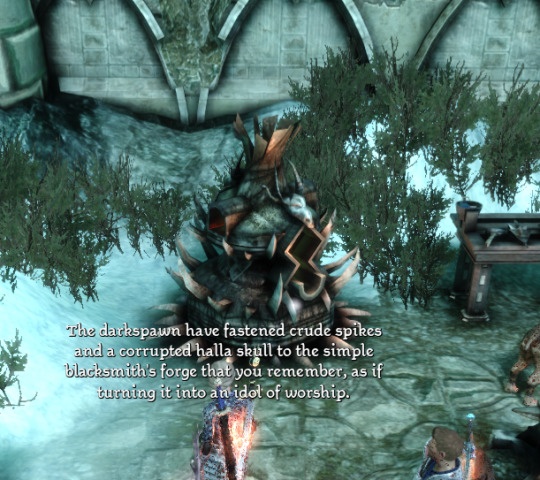
what the fuck does this mean. what did they mean by this
#tay plays dao#not to be a tinfoil hatter rn but WHY A HALLA? HMMMM?? BIOWARE ????IM IN YOUR WALLS ????????????#maybe im giving them too much credit lmaooo but u would think writers write things deliberately right.#like. u would assume someone sat down and deliberately told us that this looks like an idol of worship and it has a halla skull on it#and if so then what. WHAT. does it MEAN#smh do not make me think of horror of hormak again bc if i start thinking of horror of hormak im going to become even more annoying#abt the deep roads than i already currently am rn so
9 notes
·
View notes
Text
server storytime left on a CLIFFHANGER that was EVIL
#we're reading horror of hormak#and this poor sad boy#following his ex into certain death#<- this is a joke but also#I am just cronch cronch cronch on the warden lore#mer speaks
4 notes
·
View notes
Text
i feel like bellara seems like an elven name and not dwarven? but she says that the "rumbles are the good kind" in the 2020 behind the scenes trailer. so i wonder if she's an elf who lives underground in the deep roads or kal-sharok?
#i'm too lazy to fact check this but elves have lived/sheltered underground too haven't they?#i think it was mentioned in dao several times?#plus the ghilan'nain temple in horror of hormak was in the deep roads#idk just something i've been thinking about 🤔#💬 chatter
4 notes
·
View notes
Text
When your curiosity gets the better of you and you decide to start reading The Horrors of Hormak while having lunch
3 notes
·
View notes
Text
Tevinter Nights: The Horror of Hormak
Personal Speculation

All the non-speculative content was delivered in this [post] which only explains what the book has to offer with some screenshoots of the pages as a proof.
The chambers in this place have a constant theme: shifting horns of a halla. The change is not sudden but progressive, as the repetition of the images suggests. The columns also speak of progressive shifting, a constant iteration of the same illustration producing small changes on the picture while humanoid and monster begin to change one another.
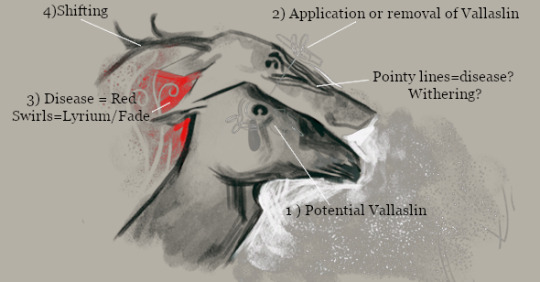
Although there are “monsters” described all along those pages, the repetitive presence of the halla is undeniable, even in the carving of the columns. This temple of shifting and mutation seems to highlight the horns of the halla, and so far, the only Evanuris we were informed as related to this animal is the mother of Hallas: Ghilan'nain. In the Temple of Mythal, where the information is more accurate only because it belonged to the time these events happened, we find out her codex explaining that she is related to the creation of giants, hallas, and other monsters. This ability is what allowed Ghilan'nain to become an Evanuris, otherwise, she would have been another one of “the people” [ a standard elf=servant?].
In this book, there are some descriptions that brought to my mind objects and elements we saw in the games:
The third band focuses on hallas, and the shape described in them reminds me of the mural paintings we find in DAI:
the hallas are wrongly depicted: they have too many horns, they look more rounded, almost insectoid-like.
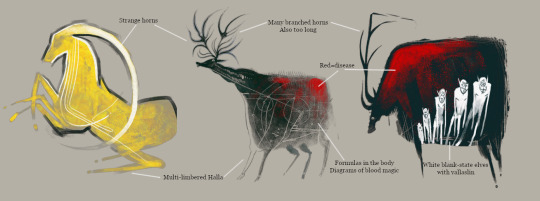
[Also include the first image of this post: the winged halla]
The structure of the last chamber, where we find the pool of grey viscous fluid [which smells like sea water] and a massive crystal of lyrium over it, reminded me immediately to Amgarrak.
In Amgarrak we learnt that a Tevinter Mage wanted to recreate a Golem made of flesh, using a massive artefact to trap “fade spirits” into the flesh golem. The process to craft these golems was not simple since, apparently, it required of Lyrium wells filled with raw lyrium over which a massive structure with Lyrium veins hovered. These artefacts powered up the whole Thaig to produce shifts in the planes.


If DAO content can still be held and compared to DAI content, I would imagine this chamber described in the book was the original artefact that "inspired" the Tevinter Mage [I’m not saying they are the same, but the fact that the brine pool fuse creatures, and in Amgarrak the spirits were forced on fused corpses, seems to share a link in the concept of fusing bodies in different states]. Both chambers seem to do something similar: fusion of spirits/bodies with others.
In Amgarrak the artefact catches spirits from the Fade and forces them into golems of fused corpses. In the artefact of Tevinter Nights it looks like it fuses living bodies AND souls. This grey pool feels like a corrupted, abandoned artefact that stopped doing its original purpose. If we follow what we learnt in the previous chamber narrated in the book, about shifting and progressive change, this pool, which I suppose used to produce that progressive shift between people and monsters, seems to be broken. It is progressive with humanoids, as Jovis says, while with darkspawn the procedure is instantaneous. Maybe the lack of soul has to do something in this.
This also brings to my mind all what we learnt in the Lost Temple of Dirthamen: Dirthamen priests and disciples had a deep knowledge of bounding souls and bodies, to the point I suspect that Dirthamen and Falon’Din had this kind of relationship, hence you can never differentiate one from the other. It’s not by chance that in the Lost Temple of Dirthamen we have no mosaic of Dirthamen, several ones of Falon’Din and one in red of Ghilan’nain. The link could potentially be the “secret of bounding spirits to flesh” [in the same fashion that the disciples ended up doing with the High Priest in this place. For more details, read the post about the Lost Temple of Dirthamen]
It’s worth noting that in the chamber of the book, the lyrium crystal glows in green-yellow-ish colours, which seems to be the usual colour of Fade-related stuff in DAI [rifts, rift magic, veilfire, possession of spirits like in Hakkon’s case].
When it comes to the interpretation of the mural with the bands, I have two possibilities:
1) The first chamber speaks of Evanuris with their slaves cowering in terror, inserting disease in them via magical procedures, and then sending them to the mountains. A simple reading of this means that the Evanuris’ slaves lived in terror, knowing the danger of being subjects of experiments (infected) by the mages and sent to the mountains. Which is strange, purposeless even, since it is in these mountains where the transformation happens. The original disease forced via magic is a previous condition for a better result of the final transformation later? Impossible to say.
2) The other interpretation I can do is in a reverse direction, from the lower band to the top: kidnapped elves, inside aravel-prisons, are sent to the mountains where they are subjected to a procedure that turns them into chimeras. The process is slow and controlled. This disease, inserted by the mages in a way or another, can be contained by the evanuris with the use of Vallaslin [which is a design made of blood and probably, originally related to blood magic]. In this way, the Evanuris had a total control on the elves wearing a Vallaslin, since without it, the transformation continues. This gave them the power to amass countless servants who lived in terror for what they had inside, only controlled by the whims of their masters.
I have [speculative] reasons to think that part of this procedure is related to the Vallaslin, simply because the paintings in DAI. We have two in particular that show the shifted/weird halla, carrying a red colour on it. The elves in white have clear signs of vallaslin on their faces.

Similar row of white-blank elves can be seen in another drawing, walking like zombies, faceless and chest erased, as if they have no mind nor heart, and a red swirly mark falls over their shoulders. As usual, this red has swirls, making it related to lyrium. All this under the Golden Ring we mostly see with the elven statue of the owl.

Another interesting detail we can take from this book is that it seems that the aravels, an iconic Dalish element, was originally to be a means for transportation of slaves. It seems very Dalish to rebuild their culture by using yet another slave element: vallaslin that determined who were their owner, aravels that were prison-ships, and hallas [Ghilan’nain’s favoured animal] “leading the path” to their destiny.
When we go to the next chamber, and we see chimerical darkspawn, plus the mosaic previously depicting unknown flowers and animals, I think this may connect with The Descent, in the codex of Ailsa’s diary, a grey warden who lives her last days of The Calling. She says the following things:
I cut through the darkspawn horde, expecting to find only more of them the deeper I traveled. But nothing has matched my expectations. "Deep Roads" brought to mind darkspawn, dwarven ruins, caverns, and death—but there's an entire underground world here. Just today, I came across plants with lyrium-streaked veins. I took a bath in a lake that held crisp, fresh water and cautious animals, large and small, that I'd never seen before. I can't be the first Warden to witness such wonders.
But then I stumbled across something horrible. I smelled it before I saw it: bodies. Hurlocks, genlocks, creatures I didn't recognize—hundreds of them, mutilated, tortured, and thrown into pits.
She points out beautiful flowers and unknown animals, which is what the Hormak’s engraving walls show. The other point is that Ailsa seems to see a pit of “failed experiments”. It’s not said explicitly, but both places state about creatures that are unrecognisable for Wardens [who have seen a lot in their lives and specially in the Deep Road]. I think it seems worthy to keep this detail in mind.
Jovis is presented as something not quite similar to a Harvester, but clearly a grotesque fusion with an insect. The Harvester in DAO and DA2 was the fusion of a spirit or a living creature with corpses; here, it’s the fusion of living creatures with different spirits, fighting for the control of their common body.
There is also something very disturbing that Jovis says: “She cannot have it. Not again.” The Again implies that she had it before. And it’s a she. With all the info we had, the straightforward conclusion seems to be the priest who used this pool to create chimeras. Ghilan'nain’s?
If you read the art of the three bands from the bottom to the top [a direction more related to hierarchy], one can interpret that twisted hallas guided prison-ships elves into places like this one we are in. Probably these twelve temples looked like heaven: temples of elven design that we have seen as beautiful, pristine even [as the book remarks], filled with beauty, flowers and strange animals. These places were beautiful for the Evanuris, not for the slaves. The Evanuris forced disease into their slaves, using animals, causing small shifts in them until the change make them into monsters. Only then, the Evanuris felt content with the result. This was the foundation of the power of the evanuris, who controlled the masses of elves out of terror. Or this could have been how they developed armies.
We also know that back then the Evanuris were at war, first with the Titans, and later with themselves. This fusing process seems to be an interesting one for creating perfect armies, as the Warden Ramesh points out in the book.
As a last detail, specially related to the “shifting”, the DAI paintings may display something of the like in their mysterious paintings: We see an elf with marks on his face that are not clear if they are Vallaslin or style lines to mark shadows. In any case, both elves always display patterns on their upper body.

The pattern in both elves is the same with only a change in the colour. The warrior one has white legs, no marks on them. The second one shows a darkening of his colours and patterns, and his legs follow the colours and patterns we see later in the lizard figure and in the halla.
At the background of the second elf we see in white the design of the Golden Ring that the owl statue always holds in its talons.
[Index page of Dragon Age Lore ]
31 notes
·
View notes
Text
i wonder if it’s possible that ghilan'nain (with the other evanuris’ support) created the darkspawn
i vaguely remember stories about one of the evanuris going into the void and bringing back the taint maybe she fucked around with it and the bas-reliefs in hormak detailed the elven mages forcing corruption into the elven slaves. maybe this is also why solas is McFuckin Pissed to learn about the wardens willingly ingesting the taint
9 notes
·
View notes
Text
The Deep Roads are Complicated, and I am in too Deep...
I've been working on and off at mapping the Deep Roads for a while now and after writing 4 pages explaining my methodology of why I think it is mapped the way I put it and then moving on to orienting the ttrpg thaig map, I realized something while taking notes on the directions mentioned and cross-referencing it to the description of Horrors of Hormak thaig description.
You can't map the Deep Roads from a top-down perspective because sometimes the roads change directions and aren't actually going in a straight line.
They need an orthographic map. Or a map that essentially bisects the mountain. The literal map in the corner of both the Origins and ttrpg maps. The maps... that have increments of depth.

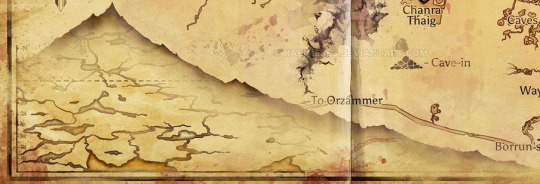
Now, I knew that the deep roads had to change elevation, especially considering how they're described and the way they're supposedly below sea level for most thaigs.
But somehow, despite knowing that, I never considered that thaigs and the roads themselves would essentially be stacked on top of each other. Don't know why that never crossed my mind up until I was checking my notes and the passages of the ttrpg and Horrors of Hormak to confirm directions. To which it finally clicked as they both explain how there are galleries/antechambers and staircases/pathways that change directions.
How do we get to the thaig?
This tunnel leads to a series of galleries. Think of them as interconnecting wide flights of stairs linked together and occasionally switching direction. We head down these for a
few hours and we’ll be on the outskirts of the thaig.
-- Dragon Age Tabletop RPG, Buried Pasts p. 18
Beside him, Lesha muttered a word and her staff began to glow. She pushed it inside the entrance to the hole, giving light to the darkness within.
The edges of the circle cast by Lesha’s spell revealed a small staircase that descended into an antechamber slightly larger than the clearing above, carved with a skill and delicacy that rivaled the works of Orzammar, or even Kal-Sharok. At the other end of the chamber, a doorway and a second staircase beyond that which spiraled into the darkness, the entire space lit by the glow of lyrium. And above the entrance, written in dwarven runes, a single word—Hormok.
-- Dragon Age: Tevinter Nights, Horrors of Hormak (p. 86)
Which then gave me pause and had me rereading and looking back at the map. Because the maps looked like they were straight and didn't initially give the impression of any verticality to them. Until you look in the corner. That's when it clicked for me and the mountains suddenly made more sense.
And now I'm screaming about it here. Because both maps are depicting a small chunk of mountain(s) in the Frostbacks. Which, for reference, my wip of the Deep Roads looked like this.
If you follow BioWare's scale of 1 square = 15 miles / 24 km - if the Deep Roads were in working order the journey to the anvil would only be roughly around 2.5-3 days journey. However, we know to get to the anvil and back to Orzammar is a month-long trip. So, with the darkspawn and collapsed tunnels it becomes a 2-week journey there and 2 weeks back. Which is quite a large jump in travel times.
I have a personal scale based on population size, megafauna, and the fact that it is supposed to take over a week to get to the Circle from Orzammar on the surface, among other travel time increments. Which makes each square 38 mi / 61 km. A 4-5 day journey from the anvil to the void when functioning.

Now, I think this map still holds up in terms of placement considering that mountains can have a wide footprint and the map on the Origins Deep Roads has at least two major peaks and a plateau, whereas the ttrpg just has one major peak and a couple of smaller ones. The ttrpg map also speaks of ravines and such so it fits the geography.
But yeah, long story short I need to revise some of my methodology; and maybe rescale the map, so things aren't super tiny.
#dragon age#dragon age maps#deep roads#dwarves#thaigs#dragon age origins#dragon age tabletop#dao#da ttrpg#long post#no cut because if I'm here you're here lost in the deep roads with me#archi is yelling
44 notes
·
View notes
Text
Tonight I'm reading the first half of THE HORROR OF HORMAK from Tevinter Nights to the DA FanFic server and I'm so excited. One of the stand out favorites in the whole collection.
Here was my pitch for why I think everyone needs to consume Hormak ASAP:

14 notes
·
View notes
Text
(Sorry I couldn't include all of them, so I sacrificed the ones I personally didn't like as much or at all lol)
11 notes
·
View notes
Text
thinking about the murals in Horror of Hormak depicting what seems to be elves being captured and turned into halla and the original myth we got about Ghilan’nain being captured and turned into a halla
8 notes
·
View notes
Photo
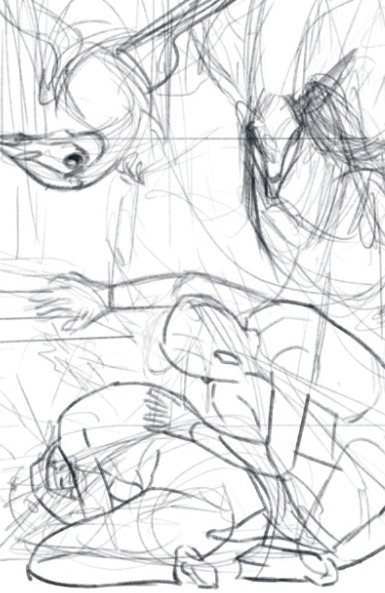
The Horror of Hormak
A piece of a sketch from a whole page spread for a Dragon Age art zine.
I can’t show much, really. If I show it in a way that is clear what is going on, then it will be more than 40% of the art (and this is prohibited by the rules).
#Dragon_Age_Zine_wip#Dragon_Age_Zine#dragon age#tevinter nights#The Horror of Hormak#Arlathan#Evhenan#Dragon Age fanart#ghilan'nain
16 notes
·
View notes